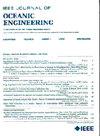AO-UOD:一种基于声光融合的水下目标探测新范式
IF 5.3
2区 工程技术
Q1 ENGINEERING, CIVIL
引用次数: 0
摘要
自主水下航行器可以携带多个传感器,如光学相机和声纳,为水下多模态目标检测提供了一个通用平台。高分辨率光学图像包含颜色信息,但不适用于浑浊水环境。相比之下,声波具有很强的穿透力和长距离传播能力,因此适用于低光、浑浊的水下环境,但声纳成像的分辨率较低。两者的结合可以发挥各自的优势。本文提出了一种利用声光融合(AO-UOD)进行水下目标探测的新方法。鉴于没有公开可用的数据集,本文首先构建了一个用于水下目标探测的光学和声纳图像融合的配对数据集。通过对准模拟的海底平面,获得了配对的声纳图像和光学图像。在此基础上,设计了一个双流交互式目标检测网络。该网络利用融合骨干、双颈、双头的结构,建立了声光信息的跨模态交互。采用注意力交互双分支融合模块实现特征间的融合。实验结果表明,AO-UOD能够有效融合光学图像和声纳图像,实现鲁棒性检测。与单模态方法相比,多模态方法可以利用更多的信息,具有更大的优势。本研究不仅为未来海洋环境下的多模态目标检测提供了坚实的理论基础,也为实际应用中的技术发展指明了方向。本文章由计算机程序翻译,如有差异,请以英文原文为准。
AO-UOD: A Novel Paradigm for Underwater Object Detection Using Acousto–Optic Fusion
Autonomous underwater vehicles can carry multiple sensors, such as optical cameras and sonars, providing a common platform for underwater multimodal object detection. High-resolution optical images contain color information but are not applicable to turbid water environments. In contrast, acoustical waves are highly penetrating and travel long distances, making them suitable for low-light, turbid underwater environments, but sonar imaging has low resolution. The combination of the two can play to their respective advantages. This article presents a novel paradigm for underwater object detection using acousto–optic fusion (AO-UOD). Given that there is no publicly available data set, this article first constructs a paired data set for fusing optical and sonar images for underwater object detection. Paired sonar images and optical images were acquired by aligning the simulated plane of the ocean bottom. Based on this, a dual-stream interactive object detection network is designed. The network utilizes the structures of the fusion backbone, dual neck, and dual head to establish cross-modal information interaction between acoustical and optical. The attention interactive twin-branch fusion module is used to realize the fusion between features. Experimental results on the data collected show that AO-UOD can effectively fuse optical and sonar images to achieve robust detection performance. The multimodal method can utilize more information and possesses greater advantages over the unimodal method. This research not only provides a solid theoretical foundation for future multimodal object detection in marine environments but also points out the direction of technology development in practical applications.
求助全文
通过发布文献求助,成功后即可免费获取论文全文。
去求助
来源期刊

IEEE Journal of Oceanic Engineering
工程技术-工程:大洋
CiteScore
9.60
自引率
12.20%
发文量
86
审稿时长
12 months
期刊介绍:
The IEEE Journal of Oceanic Engineering (ISSN 0364-9059) is the online-only quarterly publication of the IEEE Oceanic Engineering Society (IEEE OES). The scope of the Journal is the field of interest of the IEEE OES, which encompasses all aspects of science, engineering, and technology that address research, development, and operations pertaining to all bodies of water. This includes the creation of new capabilities and technologies from concept design through prototypes, testing, and operational systems to sense, explore, understand, develop, use, and responsibly manage natural resources.
 求助内容:
求助内容: 应助结果提醒方式:
应助结果提醒方式:


